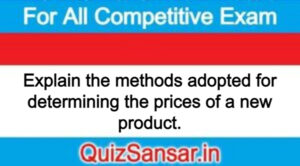
Explain the methods adopted for determining the prices of a new product.
Explain the methods adopted for determining the prices of a new product.
Ans.
Method to be Adopted for Determining the Prices of a New Product
Pricing of new product is a difficult task because demand and marketing cost of new products cannot be estimated accurately. In the case of new product marketer can adopt the following methods-
1. Skimming the Cream Strategy or A High Initial Price Strategy – Under this strategy price of new product is decided high and when competitors begin to enter in the market, the price of product is reduced. Due to it this method is known as skimming the cream strategy.
This method is adopted due to following causes-
(i) Recovery of expenditures on research, advertising, sales promotion programmes etc.
(ii) Immediate recovery of opening investments,
(iii) Attraction to consumers of high income group,
(iv) Acquiring advantage of competition less market,
(v) Suitable for luxurious products,
(vi) Establishment of equilibrium in demand and supply of product,
(vii) More profit.
In this method error or mistake in pricing can be modified.
2. Low Penetration Pricing Method – Under this method of pricing of new product price of product is decided low so that market of new product can be extended. When product becomes popular in the market, its price is increased. This strategy saves business from probable competition.
This strategy is adopted due to following causes –
(i) Low expenses on research, advertisement and sales promotion programmes.
(ii) Low production cost of product,
(iii) Acquisition of large scale economies,
(iv) Extension of market,
(v) Penetrating the market,
(vi) Attraction to low income group,
(vii) More profit earning.
There are following pricing policies:
1. New Product or Market Entry Pricing Policies: There may be new products, innovative products or immitative products to be introduced in market. In case of innovative products which are being introduced in the market following two policies are usually adopted.
(i) Market Penetration Pricing Method: In this method the price is kept low at the time when the product is introduced in the market in order to provide a footing to the product in the market. Low price and good quality are two things which help the product to penetrate the market easily. By adopting this policy the manufacturer is able to find a place for the product in market and the product is positioned well there.
(ii) Skim the Cream Pricing: By this policy the maximum profit is tried by raising the price of the product at the time of introduction. This policy is mostly successful for those products which do not have to face much competition.
2. Products Immitative of Existing Products: Such products need a very effective policy or strategy to get their place in the market. Following policies are adopted in such cases:
(i) Economical Price Policy: In this case if the quality of product is low, low price is fixed.
(ii) Highest Price Policy: The superior quality products are priced highest.
(iii) High Price Policy: Under this policy the price is kept high for a short period keeping in view its quality:
Mixed Pricing Polices
(i) Product Line Pricing: Under this policy the firms instead of producing a single product, believe in producing a product line. The products in the product line are priced differently based on their cost of production. The highest price is charged for premium product. Hindustan Lever Ltd. adopts this policy specially in their cosmetic items.
(ii) Product Bundling Pricing: Some manufacturers sell their product in the shapes of bundling. The price of bundle is lower than the total costs of units packed in the bundle. The consumer is tempted to buy the bundle because of the benefit in price. Thus those items are also sold which the consumer may not like to buy separately.
(iii) Optional Feature Pricing: Some manufacturers introduce the market related products alongwith the main product. It is left to the customer to buy the related products or not.
(iv) By Product Pricing: Some products are of such nature that after their production some raw materials are saved. The manufacturers produce by products out of the left over and sell them. If the by product is less useful the manufacturer prices the main product high to cover the cost of left over material. If the manufacturer can fetch better price of the by product he may reduce the price of the main product.
(v) Captive Product Pricing: Some products have their complement product like ink in a pen, film in camera. In such cases the manufacturer keeps the price of the main product low and by product high but such manufacturers who do not produce by products must keep the price of their product high.
(vi) Two Part Pricing: This policy is adopted by the service firms. Under this policy the price is divided into two parts (1) Permanent price and (2) Variable price. For example telephone department charges a minimum rent from the subscribers for some fixed calls. The rates for calls over and above fixed calls are different.
3. Price Policies, based on Price Level: Policies based on price levels are as under:
(i) Meeting Competition Policy: Under this policy the firm fixes the prices keeping in view the prices of competitors. The manufacturers adopt the same policies as adopted by their competitors and change their own prices with change in prices of the competitors. This policy is most suitable in situations of fierce competition.
(ii) Above the Market Price Policy: Under this policy the manufacturer keeps his prices higher than the prices of his competitors of similar items. This policy is very feasible for such firms which possesses goodwill and reputation in the market and the demand of their products in the market is high.
(iii) Under the Market Price: Under this policy the manufacturer always keeps his prices lower than market price. The idea behind it is to penetrate market and to expand the market of his product. By adopting this policy a manufacturer can well make his product enter in the market.
Promotional Pricing
Sometimes manufacturers determine the price of their product lower than its cost. The purpose is to promote sale. Such fixation of price is for a short period. Under this head following polices can be taken into account.
(i) Cash Rebate: Some firms promote sale of their product by offering cash discount on the price. The firms adopt this policy to dispose off the unsold stocks.
(ii) Loss Lender Pricing Policy: This policy is based on the assumption that consumer while buying better products of a firm also tends to buy other items of the same firm. The firm ventures to bear loss in some items and is able to increase the sale of other items. Thus the manufacturer acts as loss lender.
(iii) Warranties and Service Contracts: Some firms provide warranty and after sales service free of extra charge and thus increase sale of their products. They do not charge anything extra for these services.
(iv) Special Event Pricing: Firms try to attract customers to buy their products by allowing price reduction at special occasions like festival sale winter sale, summer sale discount etc. To avail the benefit of concessional prices people tend to buy more than the required commodities.
(v) Low Interest Financing: Firms arrange finance to their customers on low rate of interest. This policy is more practical and feasible for high priced items like cars, scooters, house, etc.
(vi) Psychological Discounting: Under this policy the price of a product is already fixed high and later significant discount is offered to customer to make him psychologically feel the advantage of big saving.
(vii) Psychological Pricing Policy: Under this policy there is a very nominal reduction in price but produces heavy psychological impact on the customer for example printing Rs. 49.95 in place of Rs. 50 as a price.
Geographical Pricing Strategies
The geographical pricing strategies are mentioned here under:
(i) Zonal Delivery Pricing Policy: The markets are segmented into geographical zones and prices for each zone are separately fixed. Under one zone the same price is charged from all customers in the zone.
(ii) Production Point Pricing Policy: Under this pricing the buyers have to bear the transportation charges. The goods are handed over to the buyer at factory/godown gate. Under this pricing policy transportation charges are not included in the price of the product.
(iii) Uniform Delivery Pricing Policy: Under this policy the product is sold to the buyers at one price irrespective of the part of country where the buyers live. The policy is adopted when charges on transportation as included in price are nominal. This policy is adopted by the retail dealers to strengthen their market position.
(iv) Basing Point Pricing: The seller assumes a city in the country and makes it as base for calculating transport charges which are to be added in the cost to determine the price. If all sellers adopts the same policy for calculation of transport charges, the buyers will have to pay a uniform price.
(v) Freight Absorption Pricing: Under this policy the manufacturer bears some part of freight and the rest of it claims from the buyer. By doing this those buyers could be attracted who live near the places of competition.
Price Adjustment Policies
Following are the price adjustment policies:
(i) Utility Pricing Policy: Under this policy the price of a commodity is fixed according to its usefulness. The firms keeps on improving utility of their products by improving their qualities and adding different attributes in them.
(ii) Resale Price Maintenance Policy: Under this policy the producer determines the minimum price of his product at which it may be resold. Any middleman cannot resale it less than that price. Such policy is adopted in case of bounded products. The producer has to enter into a contact with the middleman for resale price and the producer binds the middleman not to sell the product at price less than resale price.
(iii) Discount and Allowance Pricing: Under this policy the firms allow discount or allowances for various reasons. Under discount policy if the buyer makes the payment at the time of sale or within the stipulated period then his bill is discounted at a fixed rate. Some firms allow such discount on bulk or heavy purchases. This policy motivates the buyers for more and more purchases.
(iv) International Pricing Policy: Those firms which have a global business claim uniform price. Various factors of a each country influence the price. The economic conditions, tax system, laws, regulations, competition etc. differ in each country. The firms keep these situations and facts in view while determining the price.
Discriminatory or Differential Pricing
Sometimes firms adopts different price policies on the basis of the product, place, customer, etc. These are known as differential pricing. These are mentioned as under:
1. Product Form Pricing: Minor changes in the design or shape or size are done and the different prices are claimed whereas the core product remains the same. Such minor changes do not cost much to the manufacturer but he can get better price after such modifications.
2. Locations Pricing: The seller charges different pricing at different places for the same product when the cost of the product is the same at all place.
3. Customer Segment Pricing: Under this strategy different prices are charged from different segments of buyers. For example concessions in prices are allowed to students, army personnels, farmers, reserved category etc.
4. Image Pricing: The firm charges differently on the bases of the image of particular product. Sometime by providing attractive or convenient packing to a product firms charge prices differently.
5. Time Pricing: Differential prices are claimed on the basis of season, time etc. For example prices of fans, refrigerators etc. are reduced in winter.






